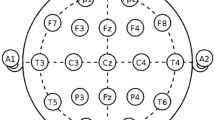Abstract
Depression is a common mental disorder with growing prevalence; however current diagnoses of depression face the problem of patient denial, clinical experience and subjective biases from self-report. By using a combination of linear and nonlinear EEG features in our research, we aim to develop a more accurate and objective approach to depression detection that supports the process of diagnosis and assists the monitoring of risk factors. By classifying EEG features during free viewing task, an accuracy of 99.1 %, which is the highest to our knowledge by far, was achieved using kNN classifier to discriminate depressed and non-depressed subjects. Furthermore, through correlation analysis, comparisons of performance on each electrode were discussed on the availability of single channel EEG recording depression detection system. Combined with wearable EEG collecting devices, our method offers the possibility of cost effective wearable ubiquitous system for doctors to monitor their patients with depression, and for normal people to understand their mental states in time.





Similar content being viewed by others
References
Brundtland, G. H., From the world health organization. Mental health: new understanding, new hope. JAMA 286(19):2391, 2001.
Bromet, E., et al., Cross-national epidemiology of DSM-IV major depressive episode. BMC Med 9:90, 2011.
Beck, A. T., Steer, R. A., and Carbin, M. G., Psychometric properties of the beck depression inventory: twenty-five years of evaluation. Clin. Psychol. Rev. 8(1):77–100, 1988.
Mundt, J. C., et al., Voice acoustic measures of depression severity and treatment response collected via interactive voice response (IVR) technology. J. Neurolinguistics 20(1):50–64, 2007.
Lehmann, C., et al., Application and comparison of classification algorithms for recognition of Alzheimer’s disease in electrical brain activity (EEG). J. Neurosci. Methods 161(2):342–350, 2007.
Grin-Yatsenko, V. A., et al., EEG power spectra at early stages of depressive disorders. J. Clin. Neurophysiol. 26(6):401–406, 2009.
Grin-Yatsenko, V. A., et al., Independent component approach to the analysis of EEG recordings at early stages of depressive disorders. Clin. Neurophysiol. 121(3):281–289, 2010.
Bhattacharya, J., Complexity analysis of spontaneous EEG. Acta Neurobiol. Exp. 60(4):495–502, 2000.
Hosseinifard, B., Moradi, M. H., and Rostami, R., Classifying depression patients and normal subjects using machine learning techniques and nonlinear features from EEG signal. Comput. Methods Prog. Biomed. 109(3):339–345, 2013.
Nicolaou, N., and Georgiou, J., Detection of epileptic electroencephalogram based on permutation entropy and support vector machines. Expert Syst. Appl. 39(1):202–209, 2012.
Knott, V., et al., EEG power, frequency, asymmetry and coherence in male depression. Psychiatry Res. Neuroimaging 106(2):123–140, 2001.
Li, Y., et al. More normal EEGs of depression patients during mental arithmetic than rest. In: Noninvasive Functional Source Imaging of the Brain and Heart and the International Conference on Functional Biomedical Imaging, 2007. NFSI-ICFBI 2007. Joint Meeting of the 6th International Symposium on. 2007. IEEE.
Li, Y.-J., Classification of schizophrenia and depression by EEG with ANNs*. In: Engineering in Medicine and Biology Society, 2005. IEEE-EMBS 2005. 27th Annual International Conference. (pp. 2679–2682) 2005. IEEE.
Eizenman, M., et al., A naturalistic visual scanning approach to assess selective attention in major depressive disorder. Psychiatry Res. 118(2):117–128, 2003.
Kellough, J. L., et al., Time course of selective attention in clinically depressed young adults: an eye tracking study. Behav. Res. Ther. 46(11):1238–1243, 2008.
Gong, X., et al., Revision of the Chinese facial affective picture system. Chin. Ment. Health J. 25:40–46, 2011.
Hall, M.A., Correlation-Based Feature Selection for Machine Learning. The University of Waikato, 1999.
Cover, T., and Hart, P., Nearest neighbor pattern classification. IEEE Trans. Inf. Theory 13(1):21–27, 1967.
Le Cessie, S., and Van Houwelingen, J., Ridge estimators in logistic regression. Appl. Stat. 41(1):191–201, 1992.
Cortes, C., and Vapnik, V., Support-vector networks. Mach. Learn. 20(3):273–297, 1995.
John, G.H. and Langley, P., Estimating continuous distributions in Bayesian classifiers. In: Proceedings of the Eleventh Conference on Uncertainty in Artificial Intelligence. Morgan Kaufmann Publishers Inc., 1995.
Amit, Y., and Geman, D., Shape quantization and recognition with randomized trees. Neural Comput. 9(7):1545–1588, 1997.
Hinrikus, H., et al., Electroencephalographic spectral asymmetry index for detection of depression. Med. Biol. Eng. Comput. 47(12):1291–1299, 2009.
Barry, R. J., et al., EEG coherence in attention-deficit/hyperactivity disorder: a comparative study of two DSM-IV types. Clin. Neurophysiol. 113(4):579–585, 2002.
Li, Y., et al., Abnormal EEG complexity in patients with schizophrenia and depression. Clin. Neurophysiol. 119(6):1232–1241, 2008.
Acknowledgments
This work was supported by the National Basic Research Program of China (973 Program) (No.2014CB744600), the National Natural Science Foundation of China (grant No.60973138, grant No.61003240), the International Cooperation Project of Ministry of Science and Technology (No.2013DFA11140), the National Basic Research Program of China (973 Program) (No.2011CB711000).
Author information
Authors and Affiliations
Corresponding author
Additional information
This article is part of the Topical Collection on Systems-Level Quality Improvement.
Rights and permissions
About this article
Cite this article
Li, X., Hu, B., Shen, J. et al. Mild Depression Detection of College Students: an EEG-Based Solution with Free Viewing Tasks. J Med Syst 39, 187 (2015). https://doi.org/10.1007/s10916-015-0345-9
Received:
Accepted:
Published:
DOI: https://doi.org/10.1007/s10916-015-0345-9




